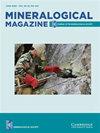Evidence of the anthropogenic origin of the ‘Carmel sapphire’ with enigmatic super-reduced minerals
IF 1.4
3区 地球科学
Q2 MINERALOGY
引用次数: 3
Abstract
Abstract Corundum with inclusions of enigmatic super-reduced minerals was found in mineral separates received as a result of alluvial sediment exploration near Mt Carmel, Israel by the Shefa Yamim Company. This corundum, registered as ‘Carmel sapphireTM’, has been an object of numerous publications by W. Griffin's scientific team, in which they propose a questionable hypothesis of sapphire formation at the crust–mantle boundary with the participation of CH4+H2 fluids. Typically the Carmel sapphire is in small fragments of breccia with white cement, which in the opinion of Griffin et al. is a carbonate-cemented volcanic ash. Our investigation of the ‘white breccia’ showed that it consists of unsorted angular fragments of Carmel sapphire from ~1 μm to 7 mm in size cemented by aluminium hydroxides (bauxite) and is a waste product of the fused alumina process, i.e. it has an anthropogenic origin. Phases typical for slags of fused alumina production and metallurgical slags were identified in the ‘white breccia’. Carmel sapphire has numerous microscopic spherical inclusions of Si–Fe alloy indicating that the removal of Si and Fe from the corundum melt occurred at a temperature >2000°С. Osbornite, TiN, from Carmel sapphire has a chemical zonation characteristic of osbornite from fused alumina with enrichment of central zones in carbon. Comparison of the growth heterogeneity of Carmel sapphire and ‘electrocorundum’ indicates that the crystallisation of the corundum melt proceeded in a similar way. Unfortunately, in the case of Carmel sapphire from the Carmel locality, the contamination of geological samples with anthropogenic material has led to popularisation of biased views.具有神秘的超还原矿物的“卡梅尔蓝宝石”的人为起源证据
摘要:Shefa Yamim公司在以色列Carmel山附近的冲积沉积物勘探中获得的矿物分离物中发现了含有神秘超还原矿物的刚玉。这一刚玉被命名为“Carmel蓝宝石”,W. Griffin的科学团队发表了大量论文。在论文中,他们提出了一个可疑的假设,即在壳-地幔边界有CH4+H2流体的参与,形成了蓝宝石。典型的卡梅尔蓝宝石是在白色胶结角砾岩的小碎片中,Griffin等人认为这是一种碳酸盐胶结火山灰。我们对“白色角砾岩”的研究表明,它由未分选的卡梅尔蓝宝石角状碎片组成,大小从1 μm到7 mm不等,由氢氧化铝(铝土矿)粘合而成,是熔融氧化铝工艺的废物,即它具有人为起源。在“白色角砾岩”中发现了熔融氧化铝生产渣和冶金渣的典型相。卡梅尔蓝宝石有许多微观的Si - Fe合金球形夹杂物,表明Si和Fe从刚玉熔体中去除发生在温度>2000°С。从卡梅尔蓝宝石中提取的硅辉石具有刚玉中硅辉石的化学分带特征,其中心带富集碳。卡梅尔蓝宝石和“电刚玉”生长异质性的比较表明,刚玉熔体的结晶过程类似。不幸的是,在卡梅尔地区的卡梅尔蓝宝石的案例中,人为物质污染了地质样品,导致了偏见观点的普及。
本文章由计算机程序翻译,如有差异,请以英文原文为准。
求助全文
约1分钟内获得全文
求助全文
来源期刊

Mineralogical Magazine
地学-矿物学
CiteScore
4.00
自引率
25.90%
发文量
104
审稿时长
6-12 weeks
期刊介绍:
Mineralogical Magazine is an international journal of mineral sciences which covers the fields of mineralogy, crystallography, geochemistry, petrology, environmental geology and economic geology. The journal has been published continuously since the founding of the Mineralogical Society of Great Britain and Ireland in 1876 and is a leading journal in its field.
 求助内容:
求助内容: 应助结果提醒方式:
应助结果提醒方式:


